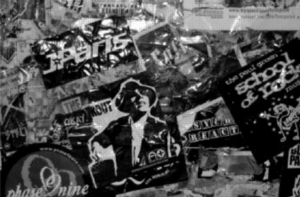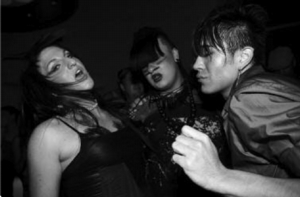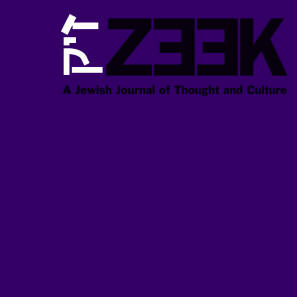 February 08
February 08
From Oi to Oy: is Hardcore Punk Suddenly Kosher?
Steven Lee Beeber
 In the beginning, they said, let there be light - a festival of lights - Eight Crazy Nights of them. And so there was.
In the beginning, they said, let there be light - a festival of lights - Eight Crazy Nights of them. And so there was.
And it was good, very good. Yidcore pelted the audience with bagels and Jewdriver wore its combination of yarmulkes and tattoos. Meanwhile the Zydepunks did their Jew Orleans klezmer shtick and director Liz Nord showed selections from her recent documentary “Jericho’s Echo - Punk Rock in the Holy Land.”
All the while, the audience pogoed and slam-danced and all but spit.
It was Hanukkah 2006 and Jewish Hardcore had come home to roost.
How strange to see Jew-centric groups working in the once antisemitic-tinged genre that counted among its members Nazi Oi (as in the taunting cry of English street toughs), bands like Skrewdriver, and legions of British fans who also belonged to the fascistic political party The National Front.
How strange to see them gathering here in San Francisco for the kick-off of the Eight Crazy Nights tour, an eight-city run of spots up and down the West Coast and Southwest.
How strange to see the nose rings, the Jewish stars, the Tevye in Fiddler on the Roof costumes.
How strange - and yet, how fitting.
For when punk started in NYC in 1974 with the emergence of The Ramones, it was already so steeped in Jewish culture that it could have been pickled like a herring. It was all about standing ironically outside of the mainstream, of joking in the “sick” style of Lenny Bruce, of looking at the world differently in the wake of the Holocaust. And it counted among its minions Joey Ramone (Jeffry Hyman), Lenny Kaye (Lenny Kasikoff), Richard Hell (Richard Meyers) and Chris Stein (of Blondie) among many many others. It was also edgy and nervous and smart-ass and smart; anti-hypocritical and political in the personal; and preoccupied with Germany and Nazis too. Just look at the Ramones’ song “Commando” (“first rule is the laws of Germany … fourth rule is eat Kosher salami”) or the Dictators’ song “The Next Big Thing” (“I used to shiver in the wings, till I found my own tongue … I knocked ‘em dead in Dallas, they didn’t know we were Jews”). Or better yet, look at Joey Ramone singing about Bonzo going to Bitburg (Reagan going to Germany’s cemetery honoring fallen members of the SS) or Dictators frontman Handsome Dick Manitoba sporting a proud Jewfro that he later adorned with a Yankees cap emblazoned with a Star of David. Or then again, what about the Lenny-Kaye-compiled punk-rock bible Nuggets, the double album anthology of pre-punk garage tunes that helped set the template for the music (young, loud, snotty), not to mention the group that Kaye later co-founded with punk godmother Patti Smith who declared at the outset of their debut album, “Jesus died for somebody’s sins, but not mine”? And where do we file the Daniel Rey (né Rabinowitz) band Shrapnel, the Russell-Wolinsky-led Sic F*ks (with their songs “Spanish Bar Mitzvah” and “We are Jerry’s Kids”), the Dead Boys and their swastikas, Chris Stein and his Nazi memorabilia collection, “Blitzkrieg Bop,” “Today Your Love, Tomorrow the World,” etc etc etc?
If punk went off the rails for a while once outside of its birthplace in the Bowery (just gobbing distance from the Lower East Side) and became infused with anti-Semitism (see The Sex Pistols’ “Belsen Was a Gas,” Siouxsie Sioux’s complaint about “too many Jews for my liking” in the original version of “Love in a Void,” X’s song about notorious LA punkster Farrah Faucet Minor who “started to hate the niggers and Jews”) and if it at times began to look as thin-skin-headed as a stormtrooper (see England’s neo-Nazi bands Skrewdriver and Brutal Attack) then maybe that was understandable too. For all things manifest themselves in different styles in different places. Like the Jews themselves, Jewish-infused punk needed to assimilate as it moved. And assimilate it did. In DC it became political (Bad Religion, Government Issue, Minor Threat). In San Francisco, anti-hippie (The Dead Kennedys, The Mutants, Flipper). In Boston, Irish (The Dropkick Murphys, The Real Kids, DMZ). In LA, celebrity assassinating (The Germs, Black Flag, X). In the UK, class conscious (The Clash, The Sex Pistols, The Damned).
And yet, here original punk was again, full circle, on the Eight Crazy Nights tour. What once had been latent in the music, what once had been part of a sub-textual code, was now out on the surface – and, in the process, perhaps not as interesting as in the beginning. For if punk were once infused with Jewishness, now Jewishness was infused with punk, or, rather, Jewish shtick was hanging its Beeber hat on punk, and that’s not at all the same thing. Rather than a complicated dance between Jew and non-Jew, New World and Old World, American and other (see The Ramones’ “Blitzkrieg Bop,” The Dictators’ “Master Race Rock” and The Sic F*ks’ “Spanish Bar-Mitzvah” for starters) this new Jewcore was Jewish to its core and more. It was too much, too Jewish as they say, infused with a parodic, one-dimensional view of “our people” as jokesters at all costs. Or perhaps that’s only how it seemed.
Once the Eight Crazy Nights tour was over eight days later, it seemed doomed to never be repeated. “People came out, but not enough,” says organizer Aaron Brickman, at the time affiliated with the San Francisco chapter of the old Jewish left’s Workmen’s Circle, today a labor organizer for airport employees. “We tried to do something and it just didn’t pay. But we showed that Jewish punk is out there. And we enjoyed ourselves. That’s what counts.”
Well maybe. And then again maybe not. For clearly something went wrong. Jewish Hardcore may have gotten some recognition. And it may even have attracted some new fans. But it’s clearly still in a precarious position of survival at this point. To understand why, let’s go back to the beginning, even to the beginning of the beginning. Let’s see if we can parse where Jewishness and Hardcore actually first met. Then we might be able to understand where they - as a pair - are going. And whether they have a future together or not.
Jewish Hardcore was in some sense there from the beginning. For when Punk - the precursor to Hardcore - first emerged in NY, it was in many ways very Jewish. Not only were most of the principals culturally of the tribe - even if not religiously - their attitudes emerged in song: there was the all-Jewish Dictators’ signature hit, “The Next Big Thing” (“I knocked ’em dead in Dallas, and I didn’t pay my dues, I knocked ’em in Dallas, they didn’t know we were Jews”); the at-least-half-Jewish Ramones (Joey, Tommy, probably Marky) song “Commando” (“first rule is, the laws of Germany … fourth rule is, eat Kosher salami”); the Jewish-led proto-punk Modern Lovers (Jonathan “If I Were A” Richman introduces “Hospital” live on “Precise Modern Lovers Order,” saying “someone asked me recently if I understood the Jewish Princess concept and in evidence … I wrote this song,”). That said, once punk was established and had moved to England and elsewhere, it began to change, gradually becoming something so different that it needed a different name to describe it.
Known as Hardcore, this new music was at first simpler, more political, taking the DIY (Do It Yourself) ethos of Punk and moving it to the next stage. As “American Hardcore” (Feral House Press, 2001) author and, recently, producer of the documentary of the same name, Steven Blush says, “Hardcore really ran with DIY … the idea of putting out your own records, doing your own touring, that aspect of taking your art out of the hands of the experts is a very entrepreneurial thing and de facto a very Jewish thing.”
 And yet, as Jewish as it may have been in the beginning (Blush cites NY bands like the all-Jewish Beastie Boys and Jewish-led D-Generation, as well as Jewish-run labels like SST and Fat Wreck Records), once it settled into its new surroundings, Hardcore began to reflect these. Now the music was louder, faster and angrier than early punk. It was also more violent in its imagery, more focused on a male audience and more earnest than ironically comic.
And yet, as Jewish as it may have been in the beginning (Blush cites NY bands like the all-Jewish Beastie Boys and Jewish-led D-Generation, as well as Jewish-run labels like SST and Fat Wreck Records), once it settled into its new surroundings, Hardcore began to reflect these. Now the music was louder, faster and angrier than early punk. It was also more violent in its imagery, more focused on a male audience and more earnest than ironically comic.
“I lived in Washington, DC [in the early ’80s]” says Blush. “Minor Threat and Dischord Records came out of there – very straight edge. I found it also to be very Christian; not in a religious sense, but in a liberal, humanist way. ‘I’m doing it for the community.’ It wasn’t about entertainment. It was nose to the grindstone, don’t have too much fun, the Puritan work ethic.”
Eventually, parts of the scene also became antisemitic. “There was a kind of schism after a while,” Blush says. “Once the Dead Kennedys began performing ‘ Nazi Punks Fuck Off!’ [in reaction to fascist elements in the British scene], members of the audience who were alienated by Hardcore’s Marxist politics became sympathetic to these sentiments. It was a self-fulfilling prophecy.”
Once antisemitism in parts of the audience met antisemitism on stage, Hardcore became not only unattractive, to many it became as regimented and hence boring as a platoon of goose-stepping Nazi automatons. Everything from the length of your hair (or lack thereof) to the color of your Doc Martin shoelaces had to fit a certain profile. In other words, rather than rebelling against the mainstream, as a Hardcore fan you suddenly became part of an alternative mainstream in which you were expected to passively follow orders.
With the music variously withering and splintering into numerous new subgenres - speed metal, thrash, nu metal, even grunge - Hardcore became marginalized and if not non-existent, then non-essential. It didn’t really speak to the needs of kids any longer. That is, except perhaps, for one of the few groups of kids that had never been able to really embrace it. The Jews.
Yes, to Jews, Hardcore may not have been verboten exactly, not exactly traif. But it was most definitely problematic. With a whole sub-genre of antisemitic (not to mention racist, sexist, nationalist, etc) neo-Nazi Oi Bands, Oy Bands like the early Ramones and Dictators seemed like a distant memory during Hardcore’s reign. Yet, more than a decade later, after grunge had begun to crash and burn and rock music in general was so multifarious in style almost anything would go, Hardcore was resurrected from the dead like the fabled Golem of Prague. It was brought back to life by Jews interested in creating their own monster; or, at least, their own comic-strip version of a monster, full of irony, comedy and dark humor.
Perhaps the first to do so was the LA-based Gefilte Fuck, a band that used to pelt its audience with the dreaded fish (much as Yidcore later did with bagels) even as its members came on stage dressed in yarmulkes (much as Jewdriver later did) and sang songs like “Dreidel” and “Smells Like Jew Spirit.”
If they never caught on, it appears that Gefilte Fuck set the template for upcoming bands that made Jewishness the focus of their acts, primarily the Beatles/Stones-like contenders on the Eight Crazy Nights tour, Australia’s Yidcore and Oakland, CA’s Jewdriver. While Jewdriver predates Yidcore by nearly five years, emerging in 1996 (out of the ruins of the briefly lived GI Jew), both make Jewishness their sole theme, and almost solely for the purposes of humor. Check out Yidcore’s eponymous debut with its rubber chicken on the cover, for instance. Hardcore versions of “Hatikva” and “Deyenu” and a play on Adam Sandler’s “Hanukkah Song” (“Why Won’t Adam Sandler Let Us Do His Song?”) say it all. A later album composed entirely of Fiddler on the Roof covers and another with two Adam-Sandler-bashing songs continue the trend, as does the band’s live act which prominently features a Hardcore version of the “Hora” While Jewdriver, who take their name from the antisemitic Nazi Oi band Skrewdriver, have a slightly more serious intent - to mock the mocking of the antisemites - their songs also reveal a shtick that sometimes shticks in the craw: from “Hail the New Dawn” to “Hail the Jew Dawn” is a pretty narrow reach, even if the goal is always and only, laughs.
Then again, as these bands continue to perform, they also seem to grow in seriousness. Yidcore’s recent album, They Tried to Kill Us, We Survived, Let’s Eat, not only deals, albeit comically, with the subject of the Holocaust, it features more songs written by the band than any album before. It’s as if focusing on more serious subjects of Jewish interest than bagels and lox, the band had begun to find its authentically Jewish voice. In fact, in doing so, the band also begins to find a much more interesting and provocative balance between comedy and something truly moving, something that goes beyond shtick to the core of Jewishness, the core of Yiddishness, the Yid Core. On the title song in particular, the band creates a video that is perfectly suited to the song’s theme of survival in the wake of oppression, a cartoon that seems like a cross between Animal Farm and Maus, with the Jews portrayed as plucked, defenseless chickens and the Nazis as fattened non-kosher pigs lording it over their prey in the most bullying fashion imaginable. In the same way that Maus’ transposition of mice for Jews and cats for Nazis made the story of the Holocaust all the fresher, universal and absurdly horrifying, so this cartoon does in some sense too. It’s kind of like the flip side of the Ramones “Today Your Love, Tomorrow the World,” a sort of “Springtime for Hitler” where the musical echoes the screams of history and the punk is all the harder core for it – not empty but meaningful, a true punch behind the lines.
With the growth in these bands, perhaps there will be a growing interest in them too. Though last year’s Eight Crazy Nights tour proved an economic bust, it still showed that there is some sort of audience for Jewish Hardcore, just as there already is for Celtic and Gypsy versions of the music.
Of course, even if there isn’t, Jewish Hardcore still says something about the relative state of Jewish consciousness in this country. While its emphasis is still on shtick and its audience is small, the fact that there is even something known as Jewish Hardcore signals an openness and pride about being Jewish that is far from that of the original punks. Though Joey, Tommy, Marky and Company played a peek-a-boo game with their Jewishness, alluding to it at times, encoding their songs with it, even occasionally stating it outright, they were essentially transitional figures toward a new style of being American and Jewish. They paved the way for Joey to eventually protest Bonzo going to Bitburg, for Fat Mike of NOFX to declaim about his Heeb brothers who liked to go out and drink brews, for Gefilte Fuck to fuck with preconceived notions of Jewishness and Nice Jewish Boys and the proper usages of certain fish. Ultimately, they also made it possible for Yidcore, Jewdriver and whoever else may be lurking out there to emerge. Jewish Hardcore it appears is suddenly kosher. Let’s hope it fares better than original Hardcore ultimately did.
Steven Lee Beeber has written for many publications, including The New York Times, The Paris Review, Fiction, Maxim, MOJO, Jewcy, Playboy.com and Spin. He is the author of The Heebie-Jeebies at CBGB’s: A Secret History of Jewish Punk (Chicago Review Press, 2006) and the editor of AWAKE! A Reader for the Sleepless (Soft Skull Press, 2007). Beeber has an essay on the Jewish punk reclamation of the New York's Lower East Side forthcoming in an anthology edited by Clayton Patterson to be published by Seven Stories Press. Read his blog here.









